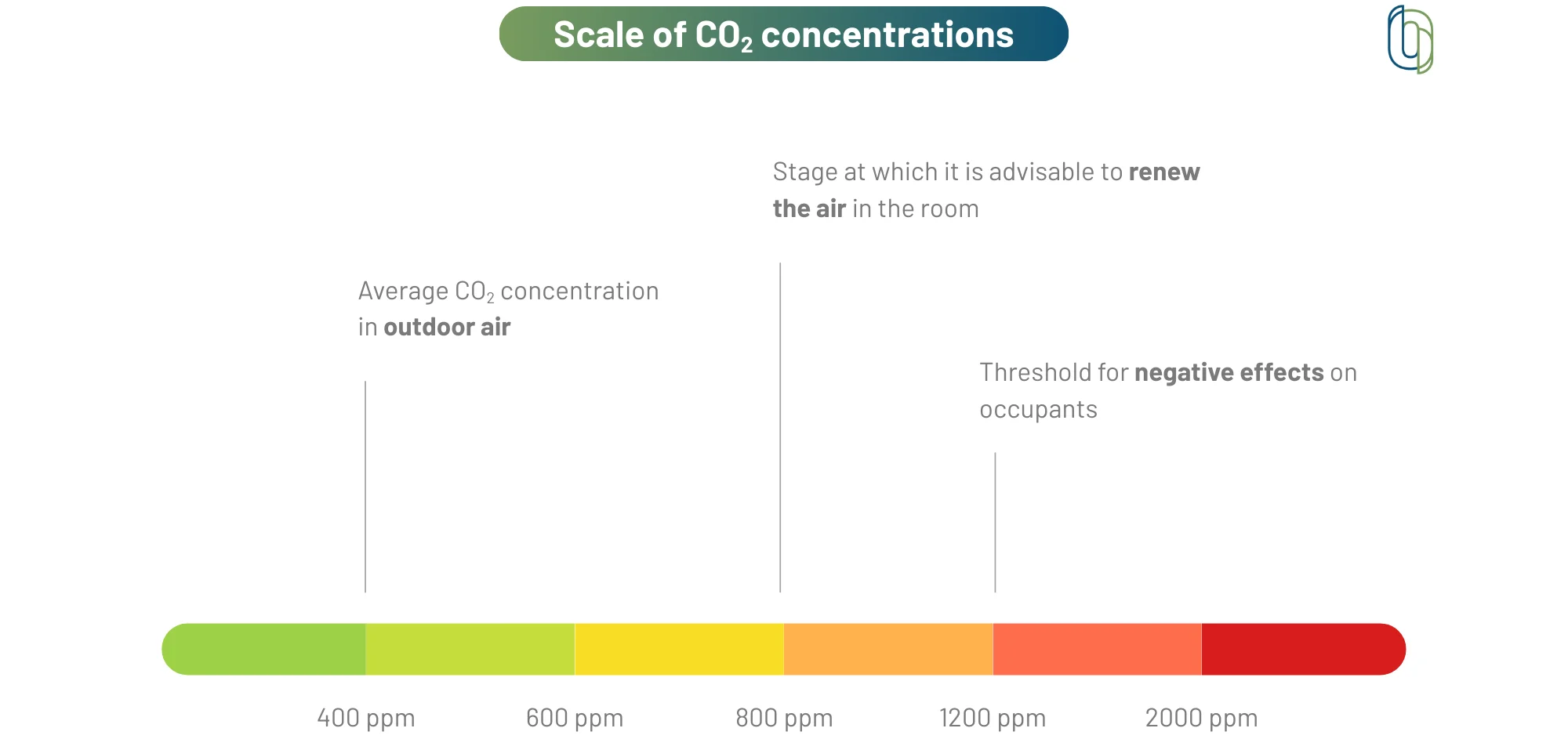BLOG
As health, regulatory, and environmental issues grow in importance, indoor air quality is becoming a key consideration in the design and operation of buildings.
However, as we spend most of our time indoors, we are exposed to a various range of indoor air pollutants. Imperceptible and often little known to the general public, these substances are likely to have serious consequences for the health of occupants, but also for their comfort.
So, where do the main air pollutants come from, and what impact do they have on health? How can their concentration be effectively limited during the design and operation of a building? Let’s find out!
The air we breathe inside buildings can contain a wide variety of pollutants. These substances come from the buildings themselves, from human activities or from the outside air.
Here’s an overview of the indoor air pollutants most frequently encountered:
Carbon dioxide (CO₂) is a naturally occurring pollutant emitted through breathing. Its concentration can rapidly increase in densely occupied and poorly ventilated spaces. For this reason, it’s generally considered a good indicator of air renewal in a room.
While CO₂ is not toxic at typical concentrations, it can still cause discomfort, including headaches, drowsiness, confusion, and fatigue.
l Note: CO₂ is also emitted by the combustion of fossil fuels such as coal, natural gas and oil. These anthropogenic CO₂ emissions act as a powerful greenhouse gas that actively contribute to climate change.

Volatile organic compounds are a family of chemical substances widely present in our interiors that can have serious consequences for human health: formaldehyde and benzene, for example, are classified as carcinogens by the International Agency for Research on Cancer.
These substances are generally found in building materials and furnishings. Paints, glues, and varnishes release these chemical gases into the air as they dry. Cleaning products, particularly strippers, degreasers, and solvents, also contribute to this issue.
l Note: when VOCs reach the outside atmosphere, they contribute to the formation of new secondary compounds that can impact the environment, such as tropospheric ozone.
Mainly produced by combustion processes such as wood burning and road traffic, particulate matter are micro-particles suspended in the air. Due to their small size, they can penetrate deep into the body, even reaching the bloodstream.
They can cause respiratory diseases (asthma, bronchitis…), cardiovascular diseases (myocardial infarction, stroke…) and neurological diseases (cognitive disorders, dementia, depression…). Responsible for 4.2 million premature deaths worldwide, they represent a major health risk.
Ozone is considered a secondary pollutant. This means that its formation is the result of a chemical reaction between several other pollutants. In this case, ozone is produced when VOCs, methane, carbon monoxide and nitrogen oxides meet under conditions of strong sunshine and high temperatures. Consequently, ozone concentrations tend to rise during the summer months,
Due to its strong oxidizing properties, ozone has a harmful effect on vegetation, causing accelerated aging and weakening of plants. Ozone is also a greenhouse gas that contributes to climate change.
Concerning human health, ozone exacerbates respiratory and cardiovascular diseases, particularly asthma.
Radon is a natural radioactive gas emanating from the soil and resulting from the disintegration of uranium. Although it is present everywhere, its concentration varies greatly depending on the nature of the soil (for example, granite and volcanic soils have higher radon levels than others).
Radon enters buildings via basements and ground floors, notably through cracks, inadequate insulation or openings. Classified as a known human carcinogen, it is one of the leading cause of lung cancer.
This category covers a wide range of biological agents. Whether of human or environmental origin, these agents can affect health in various ways, ranging from mild symptoms like coughing and inflammation of the mucous membranes to more severe conditions such as influenza, pneumonia, and legionellosis
Frequently encountered biocontaminants include molds, allergens, dust mites, and microbes.
Indoor air renewal involves replacing stale air with fresh outdoor air. This can be achieved through aeration; however, this process has drawbacks. For example, when aeration occurs duringrush hours, outside pollutants can infiltrate the building. It can also lead to heat loss in the winter.
For these reasons, we recommend an effective ventilation strategy adapted to the building’s needs. This will removes pollutants from the air, ensuring a healthy and comfortable environment for occupants.
l Note: to ensure healthy air, you need to install ventilation that provides sufficient airflow. But beware of oversizing! Over-ventilating can lead to a significant increase in energy and operating costs.

Building occupants can adopt certain measures to limit concentrations of indoor air pollutants. For instance, purchasing eco-labeled or natural products (furniture, cleaning supplies…) is an effective way to reduce VOCs concentrations.
Additionally, it’s important to properly ventilate the building. While opening windows helps renew the air, it is crucial to do so outside of rush hours to prevent external pollutants from entering the building.
Finally, to ensure efficient air circulation, don’t neglect the maintenance of your ventilation systems: air inlets and outlets need regular cleaning to prevent dirt buildup, and filters need to be replaced periodically.
Today, IAQ is recognised as a key factor in quality of life and comfort. And did you know that it is possible to address this issue right from the design phase? Our INDALO® simulation solution predicts pollutant concentrations within a structure even before it is built.
Its INCA-Indoor© air chemistry calculation engine is based on a multitude of parameters ranging from construction materials to outdoor pollution and occupant activities. It allows you to compare different construction scenarios for your future building, so you can choose the most sustainable configuration.
By identifying the most appropriate ventilation strategy at the design stage, you can reduce the investment costs involved in installing it. At the same time, you’ll reduce the operating costs associated with running your systems, as well as potential renovation work in the event of IAQ problems.
INDALO® is a decision-making tool that will help you meet your IAQ objectives, whether they are regulatory or part of an environmental certification process.

Bonjour ! C'est nous, les cookies 🍪
Nous sommes chargés de compter le nombre de visites sur ce site internet. Nous aidons énormément les personnes qui travaillent ici, car nous leur permettons d'améliorer le contenu du site internet mais aussi de rendre votre visite plus agréable.